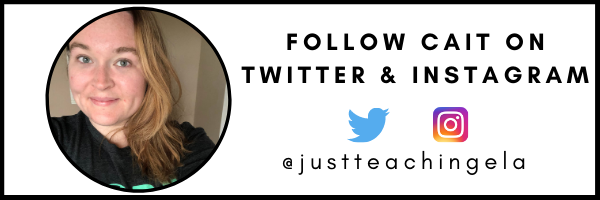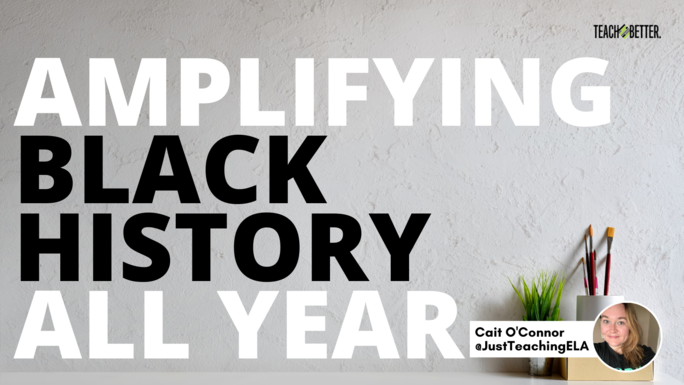TL;DR:
- Black history should be amplified all year long.
- Black voices belong in students’ curriculum and content for more than 28 days.
- Amplify Black authors and achievements in all subjects by citing Black teachers, creators, authors, and thinkers, reading text that celebrates black excellence and joy, and helping students understand Black history.
- Teach Black identity intersectionality and be mindful of the language you choose to use.
February 1 rings in Black History Month, an annual celebration of culture, literature, history, and accomplishments forged by the Black community.
But what if we celebrated Black history all year?
Black voices belong in students’ curriculum and content for more than 28 days. Here are some strategies for amplifying Black authors and achievements in all subject areas, and not just in February.
Cite Black Teachers, Creators, Authors, and Thinkers
When looking for resources to teach Black history all year, crowdsourcing is more than fine. Communities create the best lessons. However: cite! Model the act of attribution as allyship. Citing and sourcing Black educators and authors can help anchor school communities in equity work through resources and knowledge they can identify.
Some great places to look for resources are the African American Read In, Kelly Wickham Hurst’s Being Black at School, Black Lives Matter at School Week of Action. Online spaces like #DisruptTexts, #TeachLivingPoets, #ClearTheAir, #HipHopEd are outstanding. Authors like Jason Reynolds, J. Elle, Ibi Zoboi, Frederick Joseph, Dean Atta, Ben Philippe, Renee Watson, Lamar Giles, Tomi Adeyemi, Angie Thomas, Tiffany D. Jackson, and Nic Stone are revolutionary. I could not recommend the work of educators like Chanea Bond, Bettina Love, Dena Simmons, Dr. Valerie Kinloch, Victoria Thompson, Islah Tauheed, Gholdy Muhammad (author of Cultivating Genius) and Girls Who Code more highly. Check them out!
Read Texts that Celebrate Black Excellence and Joy
It’s important to acknowledge the essence and beauty and joy of Blackness alongside the struggle. Struggle is undoubtedly part of Black identity due to the pervasiveness and violence of racism. But it is not everything, and students of color in your classes need spaces where they see people who look like them doing both the mundane and extraordinary. Find texts, moments, and figures that embody Black joy, and show students the many layers of Black identity.
Black people who experience racism are also doctors, athletes, lawyers, chemists, scholars, teammates, siblings, and friends. In these identities, the reality of working “twice as hard for half as much” is palpable. However, Black students and figures deserve to be seen for their many truths and experiences, including joy and success.
Help Students Understand that Black History Didn’t Begin with Enslavement
Black history did not begin with enslavement, nor end with civil rights. Black history is living; it is now. Black history is American history and world history. And students deserve to know those histories, without a colonized filter.
Our president recently said, “Unity and healing must begin with understanding and truth.” We owe it to students to teach the truth; this does not mean altering historical facts. To encourage truth-finding, teachers can provide students a more complete picture of what happened, who was valued, who was not, who went missing, and why.
Noting and accurately unpacking the systemic struggle of Black people in and outside of the United States matters. Noting the accomplishments, achievements, existence, and resistance of the African diaspora serves all students better.
Teaching beyond the narrative of enslaved African people is to help students understand the dimensions and issues that spun out of enslavement. These include things like housing segregation, environmental racism, generational poverty, voter suppression, mass incarceration, music and culture, imperialism, colonization, diasporas, languages, and Afrofuturism, to name a few. Frame your teaching in ways that show the entirety of Black life and its complexities in context.
Teach Black Identity Intersectionality
Intersectionality is one of the most significant ways to completely understand people, events, and ideas. Intersectionality is understanding all the parts of a person’s identity. It’s important, for instance, to know when studying Amanda Gorman’s poem “The Hill We Climb,” that we not only honor her identity as a Black woman, but as a person with a disability.
We must acknowledge all the pieces of the authors, historical figures, and creators we teach. It’s important that we know that MLK actually had a gay advisor; two trans women of color led the riots at Stonewall for LGBTQIA+ liberation. It’s important to name and hold space for all the parts of the people, events, and ideas we teach. Intersectionality points us to the contradictions and complexities, helps break down barriers. It helps us, and our students, to understand that people with many layers can be visible and make a difference.
Intersectionality points us to the contradictions and complexities, helps break down barriers. It helps us, and our students, to understand that people with many layers can be visible and make a difference. Click To TweetChange Your Language
Language matters. Consider making these small changes in your language around and about students of color.
Consider what you mean by “diverse.”
I worked in a district that was only six percent white for two years, and anytime I named it, I was met with “Wow! Very diverse district.” The presence of BIPOC does not make a place diverse. If a space is composed of a majority of Black and Brown folks, that space isn’t diverse, it’s segregated. Challenge the notion that ‘diverse’ is synonymous with a lack of whiteness (it isn’t).
Speak in your own voice.
If you want to teach historically Black concepts like hip hop (like I often do in my own classroom), let authentic voices speak for themselves. Don’t rap in the classroom because you want your students to listen. Instead, teach a hip hop song that says what you want the students to know. Teachers are performers, but translanguaging through a blaccent is never helpful or appropriate. It’s okay not to know, but it’s worse when students know you’re performing a culture outside your own experience. When teaching Black students, stay true to your dialect.
Avoid false historical dichotomies and respectability narratives.
When teaching Black historical figures like Martin Luther King or Malcolm X, don’t pit them against each other. The narrative of the ‘respectable Black civil rights leader’ is one that not even Malcolm or MLK themselves agreed with. They were on the same mission, with different belief systems, and at the end of their lives, found a deep respect for each other.
Instead, frame the context or the impetus of the situation: America was not ready to hear either of their messages, because it was not ready to reckon with its legacy of segregation and racist violence. They weren’t that different. Choose to go beyond the narratives that are given in textbooks, and ask students to question who wrote those narratives in the first place. Teach beyond “I Have a Dream” and look to other dimensions and words by civil rights leaders whom we have historically deemed “acceptable” or “worthy” of studying. Resources for this exact kind of teaching can be found here.
Read and learn about figures with messy and complex histories, and avoid tone policing them just to “eliminate controversy.” Engage in critical thinking conversations: Why have we never heard this person speak before? What prejudgements do we have about them? Are those judgments going to change after we look at their work?
[scroll down to keep reading]
Keep Teaching, Reading, and Learning
As you introduce Black authors, figures, thinkers, and creators to your students, keep learning about them year-round. Read poems, essays, and texts by Black authors and continue doing the work of teaching beyond, disrupting the ways you see, read, and talk with and about Black, Indigenous, and People of Color. Black history is history that deserves a place and space in our consciousness and in our students’ consciousness all year long.
About Cait O’Connor
Cait O’Connor is a fourth-year public school English/ESOL educator in New York, committed to social justice, mental health advocacy, disrupting dominant narratives and equity in education and beyond.



